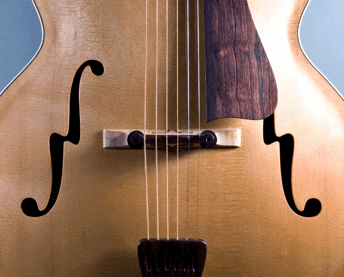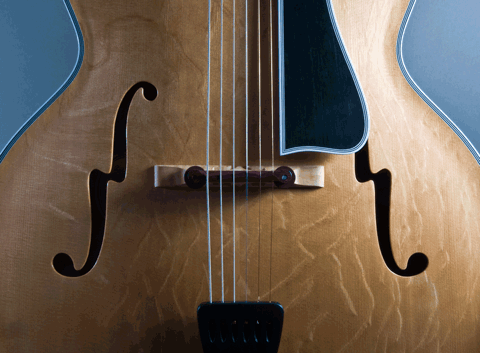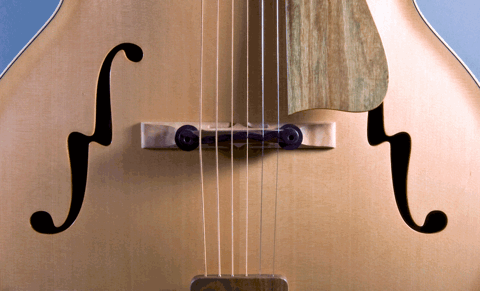Experience with violin family instruments has taught me that F holes serve two general purposes. The first is to provide an opening to the interior volume. The second is to create a zone of flexibility in the top.
Any confined volume of air with an opening to the outside world is a Helmholtz resonator, and a guitar is no exception. The resonance of the guitar body can be tuned to a frequency that enhances the low end response of the instrument, much like a bass reflex speaker enclosure. Back when I was building dreadnoughts, I remember Hideo Kamimoto telling me that good resonant frequencies to shoot for are around G or Ab (3rd or 4th fret on the low E string). My ’36 Super 400 has relatively small F holes, and the resonant frequency of the body is around Ab. This is another factor that contributes to the deep and warm sound of that instrument. In later instruments, Gibson has made their F holes much larger, and raised resonant frequencies up to the Bb or C range. Some modern luthiers go even higher, with much bigger F holes, or additional side ports. This raises the resonant frequency of the body cavity and makes the instrument sound brighter. It also makes the instrument a bit less vulnerable to feedback when amplified. I keep my F holes on the small side, for a warm acoustic sound.
Any confined volume of air with an opening to the outside world is a Helmholtz resonator, and a guitar is no exception. The resonance of the guitar body can be tuned to a frequency that enhances the low end response of the instrument, much like a bass reflex speaker enclosure. Back when I was building dreadnoughts, I remember Hideo Kamimoto telling me that good resonant frequencies to shoot for are around G or Ab (3rd or 4th fret on the low E string). My ’36 Super 400 has relatively small F holes, and the resonant frequency of the body is around Ab. This is another factor that contributes to the deep and warm sound of that instrument. In later instruments, Gibson has made their F holes much larger, and raised resonant frequencies up to the Bb or C range. Some modern luthiers go even higher, with much bigger F holes, or additional side ports. This raises the resonant frequency of the body cavity and makes the instrument sound brighter. It also makes the instrument a bit less vulnerable to feedback when amplified. I keep my F holes on the small side, for a warm acoustic sound.

The F holes introduce a zone of flexibility that allows a top to easily vibrate in more complex patterns. A lot of string energy is focused by the bridge on driving the top in and out like a diaphragm (mono-polar movement). The F holes allow the top to also vibrate more easily from side to side, or end to end. The addition of these
minute side to side (cross dipole) and end to end (long dipole) movements provides a more natural and balanced sound, whether up close or at a distance. The shape and proportion of the Skylark F holes relative to the rim, top arching and bridge is designed to optimize these cross and long dipole movements.
There is no binding on the F holes, to avoid muting the vibration of the top in this critical area.
There is no binding on the F holes, to avoid muting the vibration of the top in this critical area.


